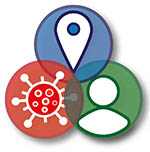
Predictive and retrospective modelling of airborne infection risk using monitored carbon dioxide
This paper, published in the Indoor and Built Environment journal and produced by researchers part-funded under Theme 2 of the PROTECT study, details a new model that has been developed to predict the risk of airborne COVID-19 infection in environments such as offices and schools. The model uses monitored CO2 and occupancy data to predict how many workers are likely to be infected by an asymptomatic but infectious colleague.
Applications of the infection model demonstrate that while most workers in well ventilated open plan offices are unlikely to infect each other via airborne particles, the risk becomes greater if the space is poorly ventilated or if the workers are involved in activities which require more speaking. For instance, the model predicts each infected person could infect two to four others in an adequately ventilated but noisy call centre. Risks are also likely to increase if the infected individual is a ‘super spreader’.






0 Comments